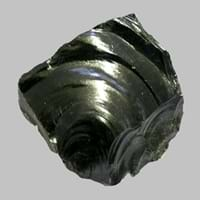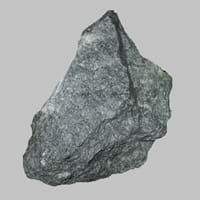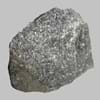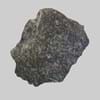Definition
Obsidian is a naturally occurring volcanic glass formed as an extrusive igneous rock. It is produced when felsic lava extruded from a volcano cools rapidly with minimum crystal growth
It is a metamorphic magnesium rich rock because it is composed of the mineral talc
Discoverer
Obsius
Unknown
Etymology
From Latin obsidianus, misprint of Obsianus (lapis) (stone) of Obsius
From 17th century, because of its greasy feel and use like a soap
Class
Igneous Rocks
Metamorphic Rocks
Sub-Class
Durable Rock, Medium Hardness Rock
Durable Rock, Soft Rock
Group
Volcanic
Not Applicable
Other Categories
Opaque Rock
Fine Grained Rock, Opaque Rock
Color
Black, Blue, Brown, Green, Orange, Red, Tan, Yellow
Black, Black to Grey, Green, Grey
Durability
Durable
Durable
Appearance
Shiny
Dull, Banded and Foilated
Interior Uses
Decorative Aggregates, Interior Decoration
Bathrooms, Decorative Aggregates, Homes, Interior Decoration
Exterior Uses
Garden Decoration
As Facing Stone, Garden Decoration
Other Architectural Uses
Not Yet Used
Curbing
Construction Industry
Arrowheads, Cutting Tool, Knives, Scrapers, Spear Points
Manufacture of Magnesium and Dolomite Refractories
Medical Industry
Surgery
Taken as a Supplement for Calcium or Magnesium
Antiquity Uses
Artifacts, Jewellery
Artifacts, Jewellery, Monuments, Sculpture
Commercial Uses
Creating Artwork, Mirror, Used in aquariums
Cemetery Markers, Creating Artwork, Gemstone, Jewelry, Manufacture of Soap, Solvents, Dyes, Plastics and Fibres, Production of Lime, Source of Magnesia (MgO)
Types
Fireworks Obsidian, Mahogany, Sheen Obsidian, Snowflake obsidian and Velvet Peacock Obsidian
Not Available
Features
Blocks negativity, Helps to protect against depression
Host Rock for Lead
Archaeological Significance
Monuments
Not Yet Used
Used
Famous Monuments
Not Applicable
Christ the Redeemer in Rio de Janeiro, Stonehenge in English county of Wiltshire
Sculpture
Not Yet Used
Used
Famous Sculptures
Not Applicable
Data Not Available
Figurines
Not Yet Used
Used
Formation
When the lava is released from volcano, it undergoes a very rapid cooling which freezes the mechanisms of crystallization. The result is a volcanic glass with a uniform smooth texture.
Soapstone is a talc-schist, which is a type of metamorphic rock and it is largely composed of the mineral talc and is thus rich inmagnesium.
Mineral Content
Not Available
Albite, Apatite, Biotite, Calcite, Carbonate, Clay Minerals, Hornblende, Ilmenite, Micas, Plagioclase, Pyroxene, Quartz
Compound Content
Aluminium Oxide, CaO, Iron(III) Oxide, FeO, Potassium Oxide, MgO, MnO, Sodium Oxide, Phosphorus Pentoxide, Silicon Dioxide, Titanium Dioxide
CaO, Mg, MgO
Types of Metamorphism
Burial Metamorphism, Cataclastic Metamorphism, Contact Metamorphism
Burial Metamorphism, Cataclastic Metamorphism, Contact Metamorphism, Hydrothermal Metamorphism, Impact Metamorphism, Regional Metamorphism
Types of Weathering
Biological Weathering, Chemical Weathering, Mechanical Weathering
Not Applicable
Types of Erosion
Chemical Erosion, Coastal Erosion, Glacier Erosion
Not Applicable
Grain Size
Not Applicable
Fine Grained
Fracture
Conchoidal
Conchoidal
Porosity
Very Less Porous
Less Porous
Cleavage
Non-Existent
Perfect
Toughness
Not Available
1
Specific Gravity
2.6-2.7
2.86
Transparency
Translucent
Opaque
Density
2.6 g/cm3
2.8-2.9 g/cm3
Resistance
Heat Resistant, Impact Resistant
Heat Resistant, Pressure Resistant
Deposits in Eastern Continents
Asia
Afghanistan, Indonesia, Japan, Russia
China, India, Indonesia, Japan, North Korea, Russia, Saudi Arabia, Singapore, South Korea, Sri Lanka, Tajikistan, Thailand
Africa
Kenya
Egypt, Ethiopia, Ghana, South Africa, Western Africa
Europe
Greece, Hungary, Iceland, Italy, Turkey
Austria, England, Finland, France, Germany, Greece, Spain, Sweden, Switzerland, United Kingdom
Others
Not Yet Found
Not Yet Found
Deposits in Western Continents
North America
Canada, Mexico, USA
Canada, USA
South America
Argentina, Chile, Ecuador, Peru
Colombia
Deposits in Oceania Continent
Australia
New Zealand
Central Australia, New Zealand, Queensland
All about Obsidian and Soapstone Properties
Know all about Obsidian and Soapstone properties here. All properties of rocks are important as they define the type of rock and its application. Obsidian belongs to Igneous Rocks while Soapstone belongs to Metamorphic Rocks.Texture of Obsidian is Glassy whereas that of Soapstone is Polished. Obsidian appears Shiny and Soapstone appears Dull, Banded and Foilated. The luster of Obsidian is vitreous while that of Soapstone is greasy. Obsidian is available in black, blue, brown, green, orange, red, tan, yellow colors whereas Soapstone is available in black, black to grey, green, grey colors. The commercial uses of Obsidian are creating artwork, mirror, used in aquariums and that of Soapstone are cemetery markers, creating artwork, gemstone, jewelry, manufacture of soap, solvents, dyes, plastics and fibres, production of lime, source of magnesia (mgo).










